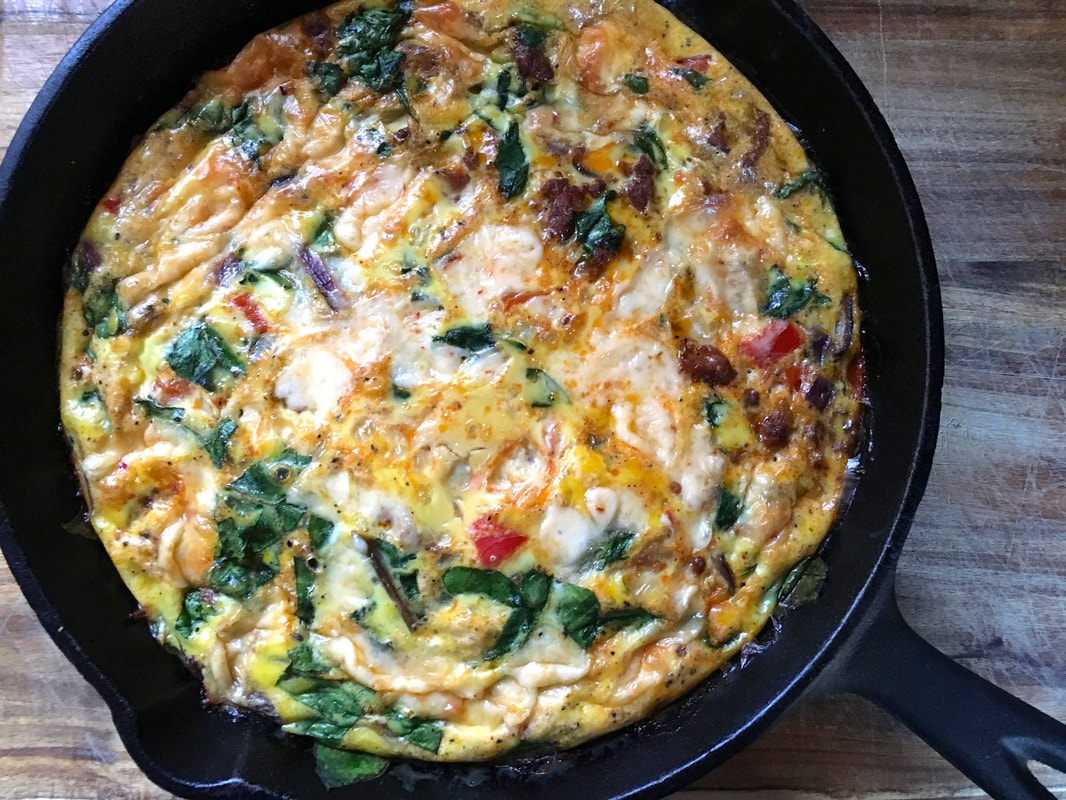 Last week, the students worked with fats and oils, tasted a panel of different olive oils, and determined the best method for making potato chips. While the recipes ranged from salads to fried foods, we also baked a bit with oil. Olive oil is a great substitution for any type of oil in a cake, muffin, or cookie recipe. Look for a fruity extra virgin olive oil to use because it will bring the most flavor to the dish. This cookie recipe is quick to bring together. The floral notes of the rosemary pair well with the olive oil and lemon. Rosemary Olive Oil Cookies Yield: 1-2 dozen cookies
Preheat oven to 350˚F. Line a sheet pan with parchment paper. In a medium bowl, whisk together the flour, baking soda, baking powder, and salt. Set aside. In a mixing bowl, cream together the sugar, olive oil, lemon zest and rosemary until smooth. Add the eggs one at a time, mixing well after each addition. Stir in the dry ingredients. Mix until combined. Roll cookies into 1-inch size balls. Place on sheet pan and sprinkle each cookie with sugar Bake for 11-13 minutes, or until golden brown. Remove from oven. Cool on the baking sheet for 10 minutes before cooling completely on a wire rack. Optional: drizzle each cookie with a glaze made from powdered sugar and fresh lemon juice.
0 Comments
 Quite honestly, eggs are one of the most perfect ingredients in the kitchen. They are used in everything from sweet to savory dishes. Even though they are widely versatile, there are times when you just want eggs. The students had a tough time picking a great recipe to share. They feasted on quiche, frittata, and a Spanish Omelet before eating macaroons, vanilla ice cream, and chocolate mousse. At the end of the day, frittata won, as it is a great and simple weeknight meal. This is a good way to clean out the fridge and use up any vegetables that might be going past their prime (looking at you, sad looking kale). You can mix and match the ingredients as you please -- bacon or ham (or not), cheese (any type), veggies -- zucchini, dark leafy greens, bell peppers, potatoes, broccoli -- all of these work well. Frittata Serves 4
Arrange a rack in the middle of the oven and heat to 400°F. Heat a 10-inch cast iron (or other non-stick oven proof skillet) over medium heat. Add the bacon and cook until until crisp, about 8 to 10 minutes. Remove the bacon with a slotted spoon to a paper towel-lined plate and pour off all but 2 tablespoons of the fat. Cook the veggies in the hot fat, starting with potatoes (if using). Allow the potatoes to cook until tender, about 5-8 minutes. Add the other veggies; cook until soft or slightly wilted for the greens. Add the garlic, red pepper flakes, and season lightly with salt and pepper. Add the bacon back to the pan. In a small bowl, whisk together the eggs, half and half, 1 teaspoon salt, and 1/2 teaspoon pepper. Pour the egg mixture over the vegetables and cheese. Bake until the eggs are set, about 15 minutes or until the center is set (not runny). Serve with bread and a salad.  Last week after enjoying a full array of meat, poultry, and seafood, the recipe that won everyone over was Pork Tenderloin with Raspberry and Chipotle Sauce. What so great about this recipe? Well, it pairs savory, herb-crusted pork with a sweet and spicy sauce. Pork generally goes well with most fruit (ahem, pork chops and applesauce). This is the type of recipe for a nice weeknight meal. Or better yet, show off your cooking skills by inviting a few friends over for a dinner party. Pork tenderloin only takes about 15-20 minutes to cook and the sauce can be made ahead of time. The sauce also goes well with roast turkey or chicken for an alternative to gravy. Thanksgiving dinner would be even better with this sauce, trust me. Note on ingredients: Chipotle peppers in adobo sauce are found in a small can in the ethnic food isle of most grocery stores. Also, pork tenderloin is typically sold in packages of two. Pork Tenderloin with Raspberry-Chipotle Sauce Serves 4-6 Pork
Sauce
Prepare the pork by preheating the oven to 375ºF. Combine the oil, garlic, sage, thyme, salt, and pepper in a small bowl. Rub mixture over the pork tenderloin. Let sit at room temperature for 15 minutes. Start the sauce by heating the oil in saucepan set over medium heat. Add the onion, garlic, and chipotle pepper. Sauté until the onions are soft, about 5 minutes. Add the raspberries and cook until the berries start to get mushy. Add vinegar and sugar. Reduce heat to medium low and simmer until the sauce reduces by about half, about 20 minutes. While the sauce is simmering, heat an oven-proof sauté pan (like cast iron pan) over medium-high heat. Sear the pork on all sides until nice and brown. Place the pan and pork in the hot oven and bake for 10-15 minutes or until the internal temperature reaches 145ºF. Remove from the oven and rest for 10 minutes before slicing and serving. Finish the sauce by straining it through a fine mesh strainer set over a bowl. Press the solids and scrape off any pulp on the bottom of the strainer. Pour the sauce back into a saucepan. Season with salt and pepper. Turn the heat to medium-high and cook the sauce until reduced slightly. The sauce can be reduced to a glaze consistency if desired. Serve the sauce over the pork tenderloin. |
AuthorNUTR 227 lab manual author and instructor: Marcy Gaston ArchivesCategories |
Home |
About |
Resources |
About Marcy |
Contact |
Copyright © 2015

 RSS Feed
RSS Feed